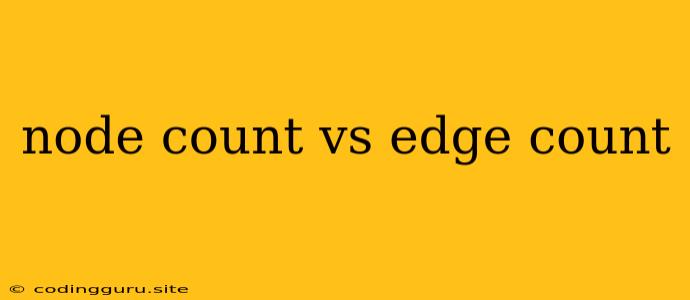In the realm of graph theory, understanding the fundamental concepts of node count and edge count is crucial for comprehending the structure and behavior of networks. These two metrics play a vital role in analyzing various aspects of graphs, from their complexity to their connectivity.
What is Node Count?
Node count, often referred to as the number of nodes or vertices, represents the total number of individual elements within a graph. These nodes can be anything from people in a social network to computers in a network infrastructure or cities in a transportation map. Each node is a distinct entity that exists independently within the graph.
What is Edge Count?
Edge count, on the other hand, represents the total number of connections or relationships between the nodes in a graph. Each edge connects two distinct nodes, indicating a specific type of relationship or interaction between them. For instance, in a social network, an edge might represent a friendship connection, while in a transportation map, an edge might represent a road connecting two cities.
Why are Node Count and Edge Count Important?
Understanding both node count and edge count is essential for several reasons:
- Graph Complexity: The combination of node count and edge count directly influences the complexity of a graph. A graph with a high node count and even higher edge count will be more intricate and challenging to analyze.
- Connectivity: The ratio between node count and edge count provides insights into the connectivity of a graph. A graph with a high edge count relative to its node count suggests a highly interconnected network, while a low ratio might indicate a more sparsely connected network.
- Algorithm Efficiency: Many graph algorithms, such as shortest path algorithms or network flow algorithms, have their efficiency influenced by the node count and edge count of the graph. Larger graphs with higher node count and edge count generally require more processing power and time for algorithm execution.
Examples of Node Count and Edge Count
Example 1: Social Network
Imagine a social network with 100 users. Each user is represented by a node, so the node count is 100. If each user has an average of 50 friends, then the edge count would be 5000 (100 users * 50 friends each).
Example 2: Computer Network
Consider a computer network with 20 computers. The node count is 20. If each computer is connected to an average of 3 other computers, the edge count would be 60 (20 computers * 3 connections each). However, it's important to note that this calculation assumes an undirected graph, meaning each connection is bidirectional. If the connections are directed, the edge count would be double, as each connection would need to be represented as two separate directed edges.
Analyzing Node Count and Edge Count
Analyzing the relationship between node count and edge count can reveal important insights about a graph. Here are some key considerations:
- Density: The edge density of a graph is calculated by dividing the edge count by the maximum possible number of edges. In a complete graph (where every node is connected to every other node), the maximum number of edges is given by n(n-1)/2, where n is the node count. Therefore, the edge density can range from 0 (no edges) to 1 (completely connected).
- Average Degree: The average degree of a node is calculated by dividing the total edge count by the node count. This metric indicates the average number of connections each node has.
- Clustering Coefficient: The clustering coefficient measures the tendency of nodes to cluster together. It is calculated for each node as the ratio of actual connections between its neighbors to the maximum possible number of connections between its neighbors. This metric reflects the local interconnectedness of a graph.
Conclusion
Node count and edge count are fundamental metrics in graph theory that provide crucial information about the structure and behavior of networks. Understanding their relationship and analyzing them can provide valuable insights into graph complexity, connectivity, and algorithm efficiency. By carefully analyzing these metrics, we can gain deeper understanding and insights into the networks we interact with daily.
